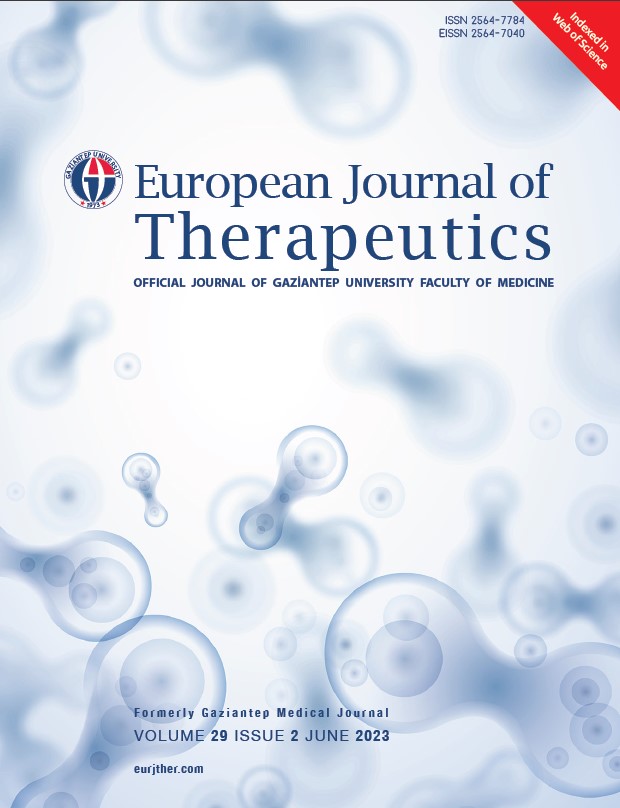Tinnitus and Cochlear Functions in Hearing Impaired and Normal Hearing Individuals
DOI:
https://doi.org/10.58600/eurjther.20232902-1603.yKeywords:
Tinnitus, TEN Test, Dead Region, Hair CellsAbstract
Background: In order to determine the pathophysiology of tinnitus and deciding on treatment, the function of peripheral hearing organs is very important.
Objective: To evaluate the cochlear functions in tinnitus patients with or without hearing-loss(HL).
Methods: Participants with tinnitus were divided into two groups; 16 participants with accompanying HL were included in the first study group (SG-I), and 15 participants without HL were included in the second group (SG-II). 21 normal-hearing subjects without tinnitus included as control group(CG). Tinnitus discomfort levels was determined with Tinnitus Handicap Inventory(THI). Besides pure-tone audiometry, Otoacoustic Emissions, to evaluate cochlear functions and to decide dead regions (DR), Threshold Equalizing Noise-(TEN) was used.
Results: The threshold-shift was observed with TEN in subjects in SG-I and these levels were statistically different from SG-II and CG. There were both threshold-shift and DR in SG-II according to TEN. TEOAEs did not differ between SG-II and CG. The DPOAE results for SG-II showed significant decreases in emission amplitudes at 6 & 8 kHz.
Conclusion: While Tinnitus patients with HL can be evaluated with conventional tests, evaluating patients with normal hearing tinnitus with additional tests such as OAE and TEN allows us to get more precise results on the functions of peripheral hearing organs.
Metrics
References
Shailer MJ, Tyler RS, Coles RRA (1981) Critical masking bands for sensorineural tinnitus. Scand. Audiol. 10(3):157-162. https://doi.org/10.3109/01050398109076176
Eggermont JJ (2012) The neuroscience of tinnitus, First.ed. Oxford University Press, UK. https://doi.org/10.1093/acprof:oso/9780199605606.001.0001
Fabijańska A, Smurzyński J, Hatzopoulos S, Kochanek K, Bartnik G, Raj-Koziak D, Skarżyński H (2012) The relationship between distortion product otoacoustic emissions and extended high-frequency audiometry in tinnitus patients. Part 1: normally hearing patients with unilateral tinnitus. Med Sci Monitor. 18(12):CR765. https://doi.org/10.12659/msm.883606
Kowalska S, Sułkowski W (2001) Tinnitus in noise-induced hearing impairment. Med. Pr. 52(5):305-313. PMID: 11828843
Ami M, Abdullah A, Awang MA, Liyab B, Saim L (2008) Relation of distortion product otoacoustic emission with tinnitus. The Laryngoscope, 118(4):712-717. https://doi.org/10.1097/MLG.0b013e318161e521
Ishak W. S, Zhao F, Rajenderkumar D, Arif M (2013) Measurement of subtle auditory deficit in tinnitus patients with normal audiometric thresholds using evoked otoacoustic emissions and threshold equalizing noise tests. Int. Tinnitus J. 18(1):35-44. https://doi.org/10.5935/0946-5448.20130006
Moore BCJ, Huss M, Vickers DA, Glasberg, BR, Alcántara JI (2000) A test for the diagnosis of dead regions in the cochlea. Br J Audiol 34(4):205-224. https://doi.org/10.3109/03005364000000131
Weisz N, Hartmann T, Dohrmann K, Schlee W, Norena, A (2006) High-frequency tinnitus without hearing loss does not mean absence of deafferentation. Hearing Res. 2 222(1-2):108-114. https://doi.org/10.1016/j.heares.2006.09.003
Thabet EM (2009) Evaluation of tinnitus patients with normal hearing sensitivity using TEOAEs and TEN test. Auris Nasus Larynx. https://doi.org/10.1016/j.anl.2009.01.002
Buzo BC, Carvallo RMM (2014) Psychoacoustic analyses of cochlear mechanisms in tinnitus patients with normal auditory thresholds. Int. J. Audiol. 53(1):40-47. https://doi.org/10.3109/14992027.2013.840931
Vernon JA, Meikle MB (2003) Tinnitus: clinical measurement. Otolaryng Clin N Am. 36(2):293-305. https://doi.org/10.1016/S0030-6665(02)00162-7
Henry JA (2016) “Measurement” of tinnitus. Otol. Neurotol. 37(8):276-285. https://doi.org/10.1097/MAO.0000000000001070
Moore BC, Glasberg BR, Stone MA (2004) New version of the TEN test with calibrations in dB HL. Ear and Hear. 25(5):478-487. https://doi.org/10.1097/01.aud.0000145992.31135.89
Møller AR, Langguth B, DeRidder D, Kleinjung, T (Eds.) (2010) Textbook of tinnitus. Springer Science & Business Media. https://doi.org/10.1007/978-1-60761-145-5
Yates GK (1995) Cochlear structure and function. Hearing, 2:41-74. https://doi.org/10.1016/B978-012505626-7/50004-2
Eggermont, JJ, Roberts LE (2004) The neuroscience of tinnitus. Trends Neurosci. 27(11):676-682. https://doi.org/10.1016/j.tins.2004.08.010
Marmel F, Cortese D, Kluk K (2020) The ongoing search for cochlear synaptopathy in humans: Masked thresholds for brief tones in Threshold Equalizing Noise. Hearing Res. 392:107960. https://doi.org/10.1016/j.heares.2020.107960
Møller AR (2008) Neural plasticity: for good and bad. Theor. Phys. 173:48-65. https://doi.org/10.1143/PTPS.173.48
Kara E, Aydın K, Akbulut AA, Karakol SN, Durmaz S, Yener HM, Kara, H (2020) Assessment of hidden hearing loss in normal hearing individuals with and without tinnitus. J. Int. Adv. Otol., 16(1):87. https://doi.org/10.5152/iao.2020.7062
Starr A, Michalewski HJ, Zeng FG, Fujikawa‐Brooks S, Linthicum F, Kim CS, Keats B (2003) Pathology and physiology of auditory neuropathy with a novel mutation in the MPZ gene (Tyr145→ Ser). Brain, 126(7):1604-1619. https://doi.org/10.1093/brain/awg156
Furman AC, Kujawa SG, Liberman MC (2013) Noise-induced cochlear neuropathy is selective for fibers with low spontaneous rates. J. Neurophysiol. 110(3):577-586. pp. 577-586 https://doi.org/10.1152/jn.00164.2013
Lobarinas E, Salvi R, Ding D (2013) Insensitivity of the audiogram to carboplatin induced inner hair cell loss in chinchillas. Hearing Res. 302:113-120. https://doi.org/10.1016/j.heares.2013.03.012
Ruggero MA, Rich NC, Recio A, Narayan SS, Robles L (1997) Basilar-membrane responses to tones at the base of the chinchilla cochlea J. Acoust. Soc. Am. 101(4):2151-2163. https://doi.org/10.1121/1.418265
Ratnayake SAB, Jayarajan V, Bartlett J (2009) Could an underlying hearing loss be a significant factor in the handicap caused by tinnitus? “ Noise and Health 11(44):156. https://doi.org/10.4103/1463-1741.53362
Newman CW, Jacobson GP, Spitzer JB (1996) Development of the tinnitus handicap inventory. Arch. otorhinolaryngol.- head neck surg. 122(2):143-148. https://doi.org/10.1001/archotol.1996.01890140029007
Downloads
Published
How to Cite
License
Copyright (c) 2023 European Journal of Therapeutics

This work is licensed under a Creative Commons Attribution-NonCommercial 4.0 International License.
The content of this journal is licensed under a Creative Commons Attribution-NonCommercial 4.0 International License.


















